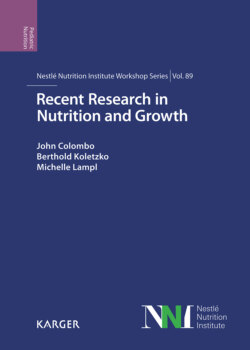Читать книгу Recent Research in Nutrition and Growth - Группа авторов - Страница 38
На сайте Литреса книга снята с продажи.
Skeletal Muscle Development
ОглавлениеThe development of the skeletal musculature can be divided into a series of temporally overlapping phases beginning with the formation of the somites of the early embryo and culminating in the fully differentiated tissue in the adult (Fig. 1) [4]. In the early stages, pluripotent mesodermal cells differentiate into muscle progenitor cells under the control of diffusible molecules. These undergo continued proliferation and migration from the somites into the various muscle beds where they fuse to form myotubes. Upon completion of this early phase, the organism has acquired its full complement of muscle fibers; in human and farm animals, this has occurred by approximately midgestation [5, 6], while in rodents it continues until birth [7]. Once myotubes have formed, a complex orchestrated change in gene expression drives the differentiation of the myofiber with the production of the complement of structural and functional proteins that confer the tissue its properties, i.e., contraction and force generation, ion and solute transport, and energy production. Concurrently, innervation and vascularization of the muscles support further specialization and refinement in functional and metabolic properties associated with the establishment of different fiber types [8]. A significant part of this developmental stage is completed within the early months of postnatal life in humans and in the early postnatal period in most mammalian species, as manifested in the advancing muscle-dependent functional abilities of the organisms.
The gain in muscle protein mass over this time is through growth in both girth and length of the myofibers. Its quantification can be assessed either from cadaver analysis, which provides an absolute measure of the whole-body amounts, or from the analysis of the cross-sectional areas of muscle fibers which provides an index of muscle size. At the end of fiber formation, approximately 20% of total body protein is in skeletal muscle; this increases to approximately 26% of body protein in the term fetus and to 40–45% by adulthood (more in males than females [reviewed in 9, 10]). These changes indicate that the accretion of skeletal muscle proteins is higher than that of other body protein pools and dominates the changes in lean body mass in the early years of life. Measurements of fiber cross-sectional areas are obtained more readily and provide greater detail on the pattern of muscle growth. These demonstrate that during the early stages of differentiation until the third trimester of pregnancy, fiber girth expands relatively slowly [5, 11]. At the onset of myofiber differentiation, there is rapid hypertrophy that continues up to 2–6 months of age [10, 11], after which growth decelerates and ceases by adolescence [10]. In rodents, a similar pattern occurs, with skeletal muscle protein mass comprising approximately 30% of body protein at birth, 45% by weaning, and then increasing more gradually to approximately 50% in adulthood [12].
